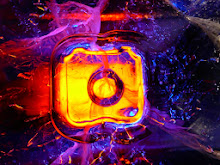
A lot is said about the 'Breed Standard' and much more written about 'it' even though, in fact, there is not one Breed Standard but at least six in existence today.
One of these is the UK Standard, recently revised by the Tibetan Mastiff Club of GB and now accepted by the UK Kennel Club; one has recently been drafted for the FCI and came into force in late 2004; a new Standard has been drafted by members of the American Tibetan Mastiff Association in the USA and voted in by a huge majority of those ATMA members: this Standard has become the official TM Standard accepted by the American Kennel Club now that the first moves have been made to take the breed under their auspices; another, from a smaller US Tibetan Mastiff club, has been in existence for some time, as has a Standard drafted by the New Zealand Kennel Club and one drawn up for the Chinese Tibetan Mastiff Club.
The oldest Standard for the breed is the Bylandt Standard of 1904, which was published in four languages. It would seem that this Standard was drafted with the help of those knowledgeable about the Tibetan Mastiffs which had, by the end of the 19th century, been sent out of Tibet, mainly to various rulers of European countries. It is more than likely that Siring, owned by the then British king, Edward the Seventh but given to him when he was still Prince of Wales, was one such dog which would have had an influence on the wording of the Standard. Other dogs would have been those sent to the German Emperor and those brought back by the Hungarian nobleman Count Szechenyi.In 1934 the Tibetan Breeds Club (of Great Britain ) drafted a Standard for use in the UK. This worthy Standard was drawn up by a number of old India and Tibet hands including the Hon. Mrs. Bailey whose love for the Tibetan breeds and her efforts to breed Tibetan Mastiffs in particular, played such a noteworthy part in the history of the breed in this country. Her effect on the breed during the middle years of the 20th century cannot be dismissed lightly and neither can her knowledge of Tibetan breeds.It was not until the 1970s that any new Standards appeared, this was the first FCI Standard for the TM and came into force in 1977. In the mid 80s a Standard was drafted by the American Tibetan Mastiff Association following the introduction of the breed to the US. This was followed fairly shortly afterwards by a revision of the UK Standard, this time based very closely on the new ATMA Standard.
After the breed had become established in the UK once again and a Club formed, an effort was made to draft a Standard which more closely reflected the Tibetan Mastiffs recorded in the writings of travellers to Tibet. Indeed in this effort, the Club was assisted immensely by people who were involved in the drafting of the Tibetan Breeds Association TM Standard in the 1930s. Regretably the only change the Kennel Club here saw fit to include was mention of spectacles. Another effort was made to review the UK Standard in 1994 and it is that revision which has now finally been accepted by the Kennel Club.This revised UK Standard will not enjoy the relevance it once would have done, since, apparently, Patronage for our breed was assumed by the FCI , possibly in 1989, but unknown to most here. Quite why the FCI should have adopted our Standard in 1996 escapes us but now advisers to the FCI have come up with the new Standard which will cover FCI countries. It could be said that the UK and the US will not be affected directly by this Standard but in todays world where more and more TMs are being exported, and shown in countries other than those of origin, every important Standard must be paid heed.


No comments:
Post a Comment